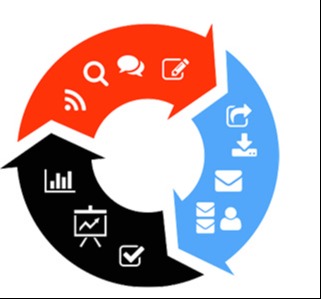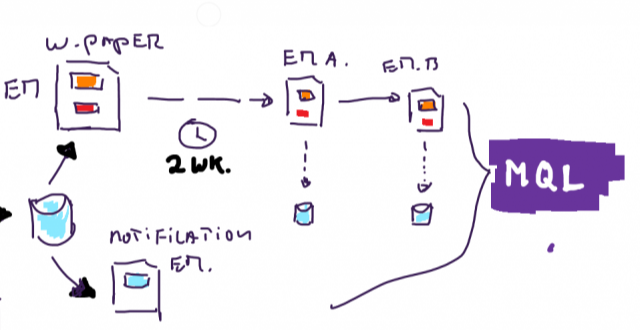Does she have blue eyes? Does he have a big nose? Is he bald? Creating buyer personas is a bit like an advanced game of "Who is it? As the game progresses, the pictures fold down lustily until you're finally left with that one person and beat your competitor. Many B2B companies still struggle with creating good buyer personas. That's why I outline ten common buyer persona pitfalls that you can easily get around. Just like the game of "Who is it?" you can save a lot of energy by asking the right questions.
Today's customer is well-informed and facilitated in their hunger for knowledge by offering a rich variety of online channels. In the competitive B2B market, acquiring new customers to achieve growth is imperative. Content marketing goes a long way in appealing to these customers. Are you going to create a buyer persona? Then don't step into the following pitfalls.
So you've started creating buyer personas for your business. Good job!
To increase the relevance of your marketing efforts, a deep understanding of who your customer is is essential. And this is where buyer personas are going to help you. Buyer personas give you insight into the behavior of prospective customers. A good buyer persona contains valuable information for your organization because they help you provide the right person with the right information at the right time. In short, buyer personas are a critical factor in creating a successful strategy.
However, there are several pitfalls lurking when creating the buyer persona. With a poor buyer persona, you can lose a lot of leads and ultimately customers due to errant content that is not targeted to your prospective customer. And that good content is exactly what ultimately motivates the visitor to purchase your product or service.
What ten mistakes are most commonly made when creating buyer personas and what can you do to avoid them?

Source image: Concentration by David Guyler
1. Focusing on the product, not the customer
A question often asked first is "what does our product do?" and "what can our product do? In short, the product is the focus. Product-centric thinking is a roadblock to customer-centric thinking and doesn't help you understand what questions and problems these prospective customers are walking around with.
In contrast, a good question when creating buyer personas is, 'what problems does our product address?' Or, "how do people feel about our product? And: 'what questions or problems does our product solve?' Only then will you look from the customer's point of view and start creating problem-solving content.
2. Creating too many personas
Many marketers set up a different buyer persona for each person with a different function, company size and industry. After all, "the more personas I create, the more people I appeal to?" With too many personas, you actually lose sight of the customer. Moreover, you lose time and energy in creating all these personas, which later turn out to be far too specific and, moreover, meaningless. In short, you achieve exactly the opposite with too many personas; lacking a clear focus, you start creating errant content that doesn't appeal to the right persona.
Setting up multiple personas is only necessary if there is an important difference between the personas. If a potential customer has the same goals and pain points as someone from a different industry, one buyer persona is sufficient. Start with one buyer persona as a starting point; you can always expand later.

Source image: lego-city-folk by Dan Goodwin
3. Base the buyer persona on assumptions
"Our customers choose us because we..." Stop! Never base your buyer persona on assumptions. Often this is an almost literal translation of the desired situation (read: what is high on the agenda at management) and you end up creating an unrealistic buyer persona. Moreover, personal preferences of customers are not going to help you draw up buyer personas, because the buyer persona must be able to represent larger groups of people.
When you let the research be guided by assumptions, you unconsciously start looking for everything that confirms that assumption. The result is likely to be a lackluster buyer persona. Of course, your gut feeling (and your experience with the customer) may play a role in it all, but start with a clean slate and let your research be guided by the insights you gain along the way.
4. Only describe demographic factors
I hear you thinking: this whole buyer persona, that's nothing new. That's right. However, the physical person behind the buyer persona (your customer) is constantly changing with the (digital) developments. Therefore, it's up to you to move with them. Setting up a buyer persona based solely on demographic factors is insufficient and outdated.
Demographic research is a good start but is not going to help you figure out pain points, values, personality, the media they use, et cetera. Which brings me to the next point.

Source image:IMG_1277byBrian Fagan
5. Only use desk research
Desk research is important and helps you get a clear picture of your potential customer's possible pain points. However, no customer is the same, and to gain insight into this customer, field research is necessary.
So get off your seat, put on your groin boots and do some old-fashioned fieldwork! Talk to the sales department and to current customers. But above all, think about getting to the bottom of customers who didn't choose you, and most importantly, why not? Use scripted interviews or online surveys as little as possible. In all likelihood, the answers will be obvious and useless: something you already knew as opposed to real, surprising customer stories. Therefore, make use of follow-up questions.
6. Using the buyer persona only for yourself
You don't create the buyer persona only for yourself. You also collect very valuable information for sales and service departments. It is a missed opportunity not to share these useful insights.
Marketing and sales should have a clear division of roles in order to address the customer at exactly the right time and offer the right content. Good marketing and sales alignment leads to success in the customer's (online) buying process.
7. Wasting time on irrelevant attributes
If you play "Who is it?", invariably the first question is "is it a man/woman?" In practice, precious hours are often lost discussing unimportant characteristics of the buyer persona.
Don't spend forever discussing the persona's gender or what he does in his free time. This may be relevant in the B2C environment but is much less interesting for B2B companies. Focus on the key priorities (specific to your industry): demographic factors, job function, job maturity, pain points, business goals, buying process and decision factors.
8. See the buyer persona as an individual person
Once the buyer persona is established, you have a solid foundation for all your future marketing and sales efforts. However, do not make the mistake of viewing the buyer persona as one individual person. You run the risk of lumping future customers together. Multiple people can fall within the profile of a buyer persona. Keep in mind that the buyer persona represents your target market and that each customer is unique.

Source image: Still, in a Crowd by Robert Swie
9. Losing sight of the main target audience
An easy pitfall is creating the buyer persona for your desired customers; a group of people you hope to appeal to sometime in the distant future. Don't lose sight of your main (current) target audience, even if this is a not very sexy group of people. Only then start working on ambitious buyer personas.
10. Forget about negative personas
In order to know who you want to appeal to, it can be useful to also map out who exactly you do not want to appeal to. Therefore, in time, also create negative personas. This way, you maintain focus and can quickly assess which people you are not going to pay attention to.
And now...
Tackle these common mistakes before you get started with B2B buyer personas, and you'll avoid the chance that a predictable, lackluster buyer persona is the result of research. If you have already started working on your buyer persona, use these tips to hone your research. Creating the buyer persona may take time, because it forms the basis for your marketing strategy!

Want to get the most out of HubSpot? Subscribe to our newsletter, follow us on LinkedIn, or attend our HubSpot User Days!
Explore HubSpot User DaysShare this
You May Also Like
These Related Stories

An efficient B2B marketing strategy in 3 steps

Lead generation in B2B: Generating leads effectively, how?


